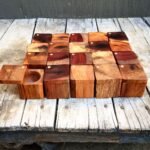The Puzzle of End Grain Woodwork
So, pour yourself a cup of coffee and pull up a chair. I wanna share a little story about the time I decided to dive into end grain woodwork. Now, I’m not a professional carpenter or anything, but I’ve had my fair share of woodworking adventures. Sometimes they’re delightful; other times, well, they’re more of a comedy routine than a how-to guide.
It was one of those weekends where the weather just begged you to be outside. The sun was shining, birds chirping—you know what I mean? After a few weeks of simply staring at my collection of tools, I decided it was time to actually use them. I’d been scrolling through Instagram, and my feed was full of beautiful cutting boards. The kind that makes you drool a little. I thought, “How hard could it be to make one?” Little did I know.
The Draw of End Grain
So, I figured I’d go big or go home and make an end grain cutting board. If you’ve never seen one up close, they’re like art. You can really see the beauty of the wood with those end grain patterns. It just felt satisfying to think about slicing through those little columns of wood, imagining it as a tangy tomato gets chopped up for a summer salad.
I decided to use hard maple and walnut; both are pretty common, but they have this rich contrast that pops. I grabbed a bunch of 1-inch thick boards, laid them out in the garage, and started planning how I’d cut them down. My first mistake? Not actually measuring twice, cutting once. I don’t know if it’s a guy thing or just my own stubbornness, but, whoops, I ended up with a few boards that were too short.
The Hum of the Tools
I grabbed my table saw, a trusty Ryobi that’s been a loyal companion for years. There’s nothing quite like the sound of a good saw cutting through wood. You can feel it in your bones—the hum and buzz, followed by that sweet scent of fresh-cut wood. But you know what? There’s also that moment where you think, “What the heck am I doing?” when the blade catches and that wood just disappears like magic.
Anyway, after some trial and error—mostly error—I managed to get my pieces to the right sizes; they were looking all right. I mean, I actually had something forming! But cutting is the easy part. The real fun began when I had to glue it all together.
The Sticky Situation
Here’s where I learned how important the clamping process is. I used Titebond III glue, which is fantastic for this kind of work. But when I got to the clamping stage, I found myself wrestling these boards together like they were hard-to-handle children at a school playdate. I had my trusty pipe clamps—those things are a lifesaver—but I kept second-guessing myself. Did I put enough glue? Did I apply it correctly? I felt like Goldilocks trying to find the perfect porridge.
I double-checked everything, trying to make sure each piece was snug. And then came the waiting part where you pace around. You know, that dreaded moment of wanting to take the clamps off ten minutes early because you’re just too darn excited? I fought the urge and left it alone for the full recommended time. A small victory!
The Sanding Saga
Now, after the glue finally set, I was elated! But then came the sanding, which, let me tell you, is like standing in a dusty sauna. The smell of the wood takes over your senses, and the sound? Pure magic—until it’s not. When I hit a knot in the wood, the sander would stall. I almost gave up then. I had that moment of self-doubt like, “Who am I kidding?” But after a few swear words and some deep breaths, I soldiered on.
I picked up my trusty random orbit sander and went after the imperfections. It was like dancing with the wood, moving in and out, and I could almost see that shiny finish coming to life. I used 80 grit, then went down to 220, which felt like the world’s tiniest miracle when I finally saw the surface shine.
The Reveal
Now, here’s the part that shocked me: when I finally finished—and I mean finished with that mineral oil and beeswax and everything—the board looked better than I had imagined. I stood back and just laughed at the fact that it actually turned out decent, despite my many missteps.
I can’t tell you how many times I thought about quitting, but it was all part of the experience. Each whir of my sander and the smell of those wood shavings somehow became way more than just a project; it was like therapy.
A Warm Takeaway
So, if you’re thinking about tackling something like end grain woodwork—just go for it. Seriously. It may feel messy and chaotic at times, and you might wonder what possessed you to try in the first place. But those moments of struggle? They make the victories taste so much sweeter. I wish someone had told me that it’s all the mistakes—every wrong cut and every stubborn piece of wood—that make you appreciate what finally comes out of it.
At the end of the day, it’s more than just wood; it’s a little piece of yourself captured in each board. And if it turns out well? Well, that’s just the icing on the cake.










